It has been a bit quite here, I haven’t had much time to sew. But that hasn’t stopped me from planning future projects and taking a look at what I got done for 2010.
Finished for 2010


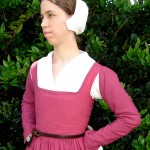
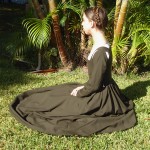
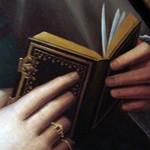

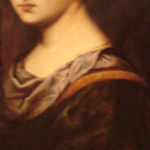
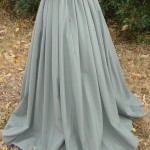
It has been a bit quite here, I haven’t had much time to sew. But that hasn’t stopped me from planning future projects and taking a look at what I got done for 2010.









I’ve been sitting on this project for some time waffling back and forth on fabric use for Henry VIII’s era and if the fabric I have can be even called mockado. I mentally went back and forth until the project had stalled due to my indecision. But In the end I’ve decided I don’t have any other use for the fabric, and I need to test the dress pattern I want to use for a different project. So this is becoming something of a wearable mock-up with some research to keep my perfectionist side happy.
I’ve long admired the sketch of “A Lady Walking” by Hans Holbein the Younger.
The dress was plain but elegant and she sported a wild headdress that must have been a pain to wear on a windy day.
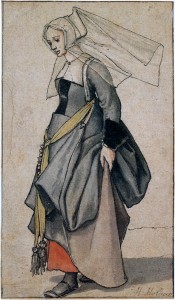
From the sketch alone: she wears a red half kirtle/underskirt/petticoat whatever you want to call it, it is most likely wool. Over that she wears a gray kirtle, most likely also wool, and over that a blue-gray wool gown trimmed with velvet.
We can’t see if the gown has a waist seam or not, we can only see that the front overlaps, possibly closing with hooks and eyes or it is pinned shut. The gown in the skirt doesn’t look like it is lined and the hem appears not to be bound. The wool is most likely felted or finished to keep it from raveling, giving it that clean edge.
The skirt is full enough that the gown might have a small train, or be floor length, hence the system of straps to keep the skirt hooked up out of the mud. If this is part of the mysterious white band is still up for debate, but a similar device is hinted at on Margaret Clement(?) in the sketch of Thomas More’s family. In the remade painting the figures are rearranged and this detail is a bit harder to see.
She also has a green, perhaps silk tasselled sash, a rosery or paternosterer at her side, small buttons on the top of her velvet cuffs, and a partlet that buttons at her throat.
The gray kirtle looks like it is the same type/weight wool as her over gown and looks to be unlined. On her feet she has the classic square-toed shoes for the era and what might be silk or fine linen stockings.

I finally finished the Brown Green wool kirtle. I had left off the last posts talking about sleeves and eyelets but once I got into the swing of things I got them done without taking any photos.
Bad me.
I was to the point of hemming the skirts, so I marked the hem and then carefully trimmed it even and overlocked the edge to keep it from fraying.
Then I put the kirtle on… and I hated it.
The bodice point came down far too long and didn’t curve in enough along the waist before hand. I looked for lack of better words, stumpy. I was not happy, I was so not happy I set the whole project aside for a month. I knew how to fix it, but taking apart an almost finished project goes against my grain. What if I messed it up?
After it sat for a month in time out, I got annoyed one night and decided that was it. I was going to fix it and if I messed up well then I’d have a brown/green petticoat. So I unpicked the front of the skirt and trimmed down the bodice point by two inches.
That fixed it, even if it turned my nerves into noodles.
Then it was just binding the hem and it was done.

I have finished the sleeves for the brown turns out it is actually green wool kirtle. All they need is lacing rings or pins to keep them on and then I’ll be able to take some photos. I used version 34873434 of my basic sleeve pattern that I’ve tweaked and adapted over the years. They are a bit loose to make sure I can bend my elbow when I have my smock on. Cause flexibility is a wonderful thing!
I might have just enough wool left over to make a doublet, but I won’t know for sure until I find my doublet block, which has once again disappeared from all existence. I have no idea if I still have the muslin mock ups I used for that pattern. So some Spring, er Fall cleaning in due for the tiny corner that serves as my sewing space. I’ll take photos of the space if I ever get it clean enough to photograph. Thread bits and dust and bottle of glue and scissors can really take up some space when they want to.

When I last posted about this project the skirts were done save for the hem.
So it is time to move on to the bodice!
When I cut the bodice out I had no lining or interlining with me, it was all at home. Then once I got home my sewing plans were put on hold due to an accident with a bench grinder and my thumb.
It was a small hurt but it put a stop to any hand sewing, and made the project take a bit longer then it should have.
For the bodice used my mock-up pattern for the Pisa gown, which in turn was based off my block pattern that I use for almost everything. I had high hopes for it, and decided while I could not hand sew I would indulge in some machine sewing where it would never show.
I cut out a layer of heavy twill for interlining and a layer of muslin and then zig zag stitched the two together, in period this layer might have been pad stitched. But the machine zig-zag does the job pretty well.
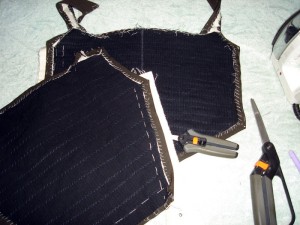
I then set the project aside.
Once my thumb had healed I set about re-ironing the pieces and then basted the muslin to the wool. I then turned the wool edges over and stitched them down to the interlining with the whip stitch. This goes pretty fast as you don’t have to use tiny fine stitches. After all what if you have to unpick something to fix it?
Then I cut out some fine black linen I had been saving and slip stitched it in by hand with silk thread.
I went all around the top, the straps and the side edges. I left the bottom of the bodice open because I had yet to attach the skirts and wasn’t sure how I was going to go about it. Since I was not lining the skirts I didn’t want to do the usual fold the edge over or face it and whip stitch into place. It seemed like that would give me unnecessary bulk that would show through.
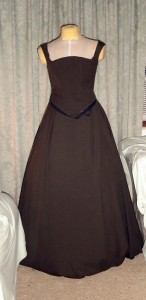
So instead I carefully hand basted the skirt in place just to the wool and interlining, cutting the V for where the bodice met the top, which in retrospect might not have been needed. I then back-stitch the skirt to the bodice by hand along the edge. There is a note in Patterns of Fashion where Janet Arnold speculates the skirt of Elenora di Toledo’s gown might have had the skirt top stitched to it. I did the same to the back of the skirt after knife pleating it.
I sewed the linen lining down next and then started on the eyelets.

I’ve started putting together a list of Tudor and Elizabethan Wills and Inventories that are available in full preview through Google Books. I’ve also included a few useful books that only have a limited preview. I hope these lists will help make it a little easier for people who are looking for clothing or household information on the web.
There are some overlaps between the two sections, and I am still adding notes to what each book is.

Where we last left off I decided to make a test draft of the Alcega pattern in newspaper, it won’t show me the drape of the fabric. But it will give me a better idea on layout, as my fabric is not as wide as the rash cloth.
Painter’s tape is useful for many things.
I then set about to tracing around the pattern and adding seam allowances. When I reached a point where the pattern over hung the fabric I folded it back and cut along the fold so I would have the perfect sized gore.
For the bodice pattern I had a mock-up with me that was similar. So traced along that, adding an inch to the top of the center front to give it the slightly arched neckline. I did the same for the back and then carefully cut out my wool.
I knew I was not going to line the skirt of the kirtle, But I also did not want machine zig zag stitching or a serged edge to show, and I was without my sewing machine. So I decided it would be a good time to try Laura Mellin’s technique for an Elizabethan seam.
My seam allowances were 1″ so I carefully folded each edge in 1/2″ and pinned it down to the ironing board and pressed. Then once it was cool I folded it over again and once more pressed. This gave me a guide to follow that was reasonably even. If I use this method again I think I will make a folding jig to help speed things up.

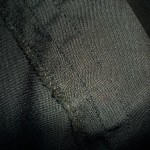
In most 16th century clothing linen thread was used for basic sewing, however I did not have any with me. So I used black Gutterman silk thread which I waxed with bee’s wax for extra strength. In the course of 2 days* I sewed the skirt together, pressing the seam allowances down as I went. The sewing method was enjoyable, and gave me a sturdy seam that did not affect the drape of the skirt.
With the skirt finished, save for the hem I was ready to start on the bodice.
*I do not recommend this, I had lots of time on my hands and really wanted to sew. But there is such a thing as too much sewing when your fingertips really start to hurt. Lesson learned…at least for now.

This project came about during a small session of retail therapy and the joy of finding wool in Florida, in the summer for 5 bucks a yard.
That was the good news.
The bad news, there was only 3 yards of it. I decided to get it anyways thinking I could at least make a doublet and sleeves.
But once I got to the cutting table a plan had come to mind. The kirtle and low-cut bodice of cloth rash from Juan de Alcega’s pattern book was haunting me. Something about the diagram hadn’t added up when I tried to use it before, and that bothered me.
So I decided I would take another crack at it. I had 3 yards of brown wool and 3.5 yards of a navy wool. And while I have 2 lower class looking kirtles a nicer wool one couldn’t hurt.
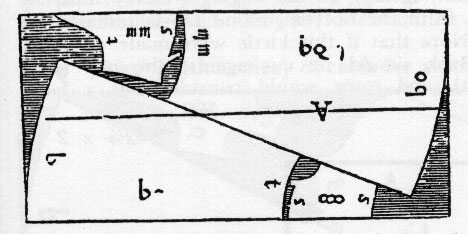
I spent the evening studying the diagram, and looking back over Deciphering Juan de Alcega Tailor’s Pattern Book.
The mm at the back waistline was throwing me off, how could it be 33 inches on the fold when the section of fabric it was laying on was only 16.5 inches wide? The total back waist measurement would have been 66 inches in all, which was more than the width of my fabric to start with. There was also an mm at the bodice length, which would make a pattern for a giant.
Something had to be amiss, so I looked over the other diagrams and found other skirts had simply m for their back portions.
Typos even with the printing press.
That problem solved, I taped together some newspaper and drafted the pattern to the measurements Alcega suggested just to make sure there were no more surprises.